Final report for ONE16-253
Project Information
The objective of this project was to document the change in nutritive quality and fatty acid content of annual forages as they mature over time, on a whole-plant basis as well as on the basis of the plant fractions that are actually consumed by grazing dairy cows. Knowledge gained from this study will influence decisions of producers and extension professionals in regards to choosing grazing pressures that optimize feed quality and fatty acid content and profile of annual forages, in regards to the economics of supplemental grazing of annual forages, as well as influencing future research.
In field trials conducted in cooperation with the Choiniere Family Farm in Highgate Center, Vermont, we found that whole plant quality declined rapidly for both winter rye and pearl millet. However, leaf blade quality remained at a high level until plants reached early heading stage. Changes in the proportion of leaf blades to pseudostem (leaf sheath, stem, and culm) was found to be the greatest factor affecting the decline in nutritional quality and fatty acid content of winter rye and pearl millet as they matured. For example, crude protein dropped from 18% when sward height was about 20 inches (recommended height for grazing) to 12% when height was 48 inches; however, leaf blade protein remained high for most of that period of time. Hourly changes in water-soluble carbohydrates of pearl millet showed a slight accumulation of WSC throughout the day for both leaf blades and pseudostems; however, overall trends were not very large and, based on this data, we would not expect much difference in animal performance whether grazed mid to late morning or later in the day.
Grazing management practices that reduce grazing pressure and/or stocking rate could allow for more selective grazing of leaf blades, resulting in a higher intake of high quality forage that is higher in protein, lower in ADF and NDF and higher in NDF digestibility and fatty acid content. This could be particularly important if annual forages have matured past their recommended heights for grazing since the proportion of leaf blade to pseudostem had declined.
- Assess the changes in nutritive quality and fatty acid content and profile of cool season (winter rye) and warm season (pearl millet) annual forage with increasing plant maturity
- Evaluate the nutritive quality and fatty acid content differences in leaf and pseudostem (leaf sheath, stem, and culm) fractions and how this affects changes in whole plant forage quality as plants mature.
- Estimate dry matter and plant fraction intake of annual forage by grazing dairy cows
- Investigate the hourly changes in water soluble carbohydrates in summer annual forage to determine optimum grazing time of day.
- Disseminate research findings to farmers, researchers and outreach educators.
Annual forages are increasingly being considered by dairy producers to maximize their grazing, supplement perennial pasture, and/or to renovate pastures. High quality annual forages can be especially important for organic dairy producers switching to “grassmilk” production to meet consumer demand for dairy produced without grain. The market demand for grassmilk is soaring, particularly in the Northeast. Grassmilk producers receive a $4 cwt premium with additional $1 cwt available to offset costs of fertility previously sourced from purchased grain. This allows organic dairy farmers to achieve greater economic sustainability – provided their forage-only rations are of high enough quality to maintain healthy and productive cows.
Cool season annuals provide high quality grazing before perennial pasture has fully emerged from dormancy. Summer annuals are similarly used to provide grazing in mid-summer, with C4 photosynthesis allowing increased productivity relative to C3 pasture. Grazing availability is important for organic producers to meet the National Organic Program 30% minimum dry matter intake from pasture rule, and for producers seeking optimal fatty acid (FA) content. Some grassmilk farmers use annual forages for relatively quick strip grazing, after bringing their animals in from perennial pasturing and before P.M. milking in the role of “grain bin”, adding energy at times of low perennial pasture productivity.
Substituting high energy forage for grain can benefit any dairy farmer as grain purchases can be over 40% of operating costs for farms, particularly so for organic producers with grain prices often 300% that of conventional. Substituting any farm-produced forage for purchased grain is a further environmental benefit as it reduces the amount of phosphorus being “imported” to the farm as grain.
A challenge with annual forages is that they quickly decrease in nutritional and FA content with increasing maturity because their architecture often leads to lower proportions of leaf blade. Conversations with dairy farmers however, advise that grazing relatively quickly through annual forages allows for high selectivity, choosing high quality sections of the plant. Milk production and FA profile from farms that graze supplemental summer annuals is possibly more ideal than might traditionally be expected considering nutritive and FA contents of whole plant summer annual forage samples.
Cooperators
Research
This research was conducted at the Choiniere Family Farm in Highgate Center, Vermont. Guy and Matt Choiniere milk about 90 cows on their farm, certified organic in 2002. In 2014, the Choinieres switched to producing “grassmilk” for Organic Valley Co-op. The Choinieres incorporate various annual forages as a supplement to their permanent cool season pastures. This project involved three separate studies described below that were conducted on their farm. With these studies, seeding choice and rate as well as soil amendments, manure and grazing practices were all in accordance with the Choiniere’s current practices. Briefly; dairy cattle were appropriately fenced to strip graze the annual forages – winter rye in early spring, and warm season annuals in mid-summer – for approximately one to two hours prior to their P.M. milking. The annual forages were strip grazed from one end of the field to the other – therefore daily strip grazing progressed from forage in an early vegetative stage at day 1 to a later elongation or early reproductive stage by the time the cows reach the other end of the field.
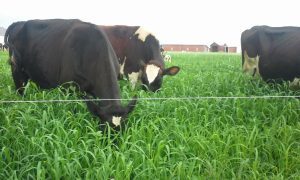
Study 1. Winter Rye Quality and Maturity - In early fall of 2015, a two-acre strip (primarily silt loam) was seeded to winter rye to be used for supplemental grazing in early spring 2016. In spring of 2016, sampling began the same day but just prior to the first day of grazing when the stand was in early elongation stage approximately 16 inches in height. The strip was also sampled on Day 5 (boot stage) and 9 (head emergence) within each area to the grazed, respectively. Th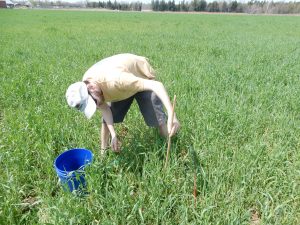 e time interval was quite short due to the rapid maturity of the rye. During each sampling date, five replicate samples were randomly collected within the strip area using a 2.5 square foot quadrat and handheld electric clippers. Rye forage was cut to a stubble height of two inches. As soon as possible after sampling (within 30 minutes), each sample was divided into leaf blade and pseudostem fractions, separated just above the ligule. To degrade any enzymatic activity that might reduce fatty acid content or water soluble carbohydrates, a 150 gram subsample of each fraction sample was heated in a microwave for one to two minutes soon after sampling. They were then transported to the UVM Horticultural Research Farm where they were dried at 60 C in a forced hot air dryer for 48 hours.
e time interval was quite short due to the rapid maturity of the rye. During each sampling date, five replicate samples were randomly collected within the strip area using a 2.5 square foot quadrat and handheld electric clippers. Rye forage was cut to a stubble height of two inches. As soon as possible after sampling (within 30 minutes), each sample was divided into leaf blade and pseudostem fractions, separated just above the ligule. To degrade any enzymatic activity that might reduce fatty acid content or water soluble carbohydrates, a 150 gram subsample of each fraction sample was heated in a microwave for one to two minutes soon after sampling. They were then transported to the UVM Horticultural Research Farm where they were dried at 60 C in a forced hot air dryer for 48 hours.
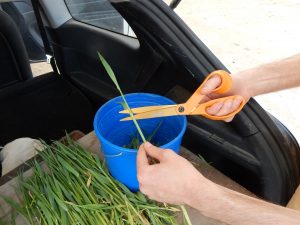
After complete drying, samples were then weighed to establish dry matter weights and yield of both fractions, ground with a Wiley mill (Arthur H. Thomas, Philadelphia, PA) to pass through a 2mm screen, and then a cyclone forage mill (UDY Corporation, Fort Collins, CO) to pass through a 1mm screen, and analyzed for forage quality using Near Infrared Reflectance Spectroscopy (NIRS) according to the procedure developed by the NIRS Consortium (NIRSC, Hillsboro, WI) program of the National Forage Testing Association (NFTA, Avoca, NE). Fatty acid content was determined as described by Goossen et. al. (2018). Dry weights of leaf blade and pseudostem fractions of pre-grazing samples were used to calculate DM yield, nutritional quality, and fatty acid contents of both fractions and total plant samples.
There was an attempt to collect post-grazing samples on these same three days but there was too much trampling and some of the annual plants were literally pulled out of the soil making our method too variable and unreliable. Therefore, we were unable to estimate dry matter intake and all our analysis is based on pre-grazing data.
Study 2. Pearl Millet Quality and Maturity - In June of 2016, the Choiniere’s planted strips of several summer annual mixtures. To minimize variability, we only sampled from a monoculture of pearl millet strip. Because of a dry summer, we knew there would not be time for significant regrowth of the millet; therefore, we sampled more frequently through the grazing period of the one growth period. There were six sample dates over a 19-day period beginning on July 18, the first day of grazing, when the stand had reached about 20 inches in height until August 5, when the forage was in early head stage. Other than cutting to a stubble height of 15 inches, our sampling procedure and processing was the same as that described above with winter rye.
Study 3. Diurnal Variation in Water Soluble Carbohydrates of Pearl Millet Forage - The objective of this study was to evaluate hourly changes in water-soluble carbohydrates of pearl millet when it reached

maturities suited for grazing (18 to 20 inches in height) and harvesting for silage (25 to 30 inches). On July 19 and July 26 of 2017, we collected two sets of samples at approximately one hour intervals starting at 7am and ending at 7pm. Samples were cut with electric hand clippers from a 20 x 20 inch quadrat leaving a 4-inch stubble. For each quadrat, the total number of tillers were counted and lamina (leaf blade) was separated from pseudostem (grasses at this stage do not have true stems but rather a combination of leaf sheaths, elongating culm, and pre-emerged new leaves all collectively called pseudostem). Samples were microwaved for one minute and then placed in a forced air dryer for 48 hours until dry. They were then ground and evaluated for WSC, crude protein (CP), acid detergent fiber (ADF), neutral detergent fiber (NDF), and NDF digestibility with 48 hour fermentation time (NDFd48) using near infrared reflectance spectrophotometry (NIRS).
Study 1 and 2: Changes in Nutritional Value of Winter Rye and Pearl Millet -
Results showed that quality decreases associated with later maturity are resultant from both declines in the nutritive quality of stem and leaf components, and a greater amount of stem material relative to the total (Tables 1, 2, 3). While NDF content increased 8 percentage points in rye (Table 1) and pearl millet leaves (Table 3), the already higher stem NDF content increased from 9 percentage points in rye and pearl millet. When this is coupled with more stem elongation than leaf growth, we see overall increases in NDF content 45% to 63% in rye and from 57% to 69% in pearl millet, on a whole plant basis. Over the course of the grazing cycle, rye leaf yields showed almost no increase, while rye stem portions more than tripled their dry matter content. Pearl millet leaf yields doubled, while stem components increased by a factor of 40. Fatty acid content of rye leaf and stem components declines near the end of the grazing cycle, but overall content is more greatly impacted by the higher proportion of stem material (Table 2). Changes in FA of pearl millet were affected in a similar manner; however, the proportion of leaf to stem was far higher in the millet compared to the rye.
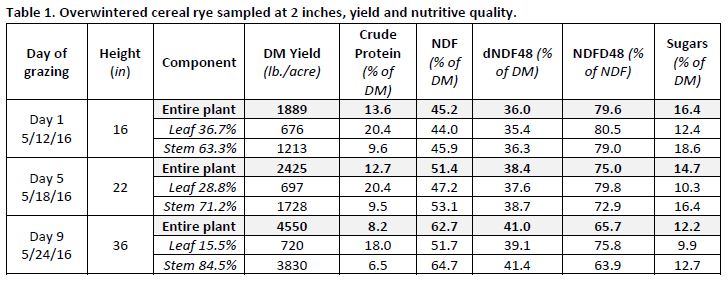
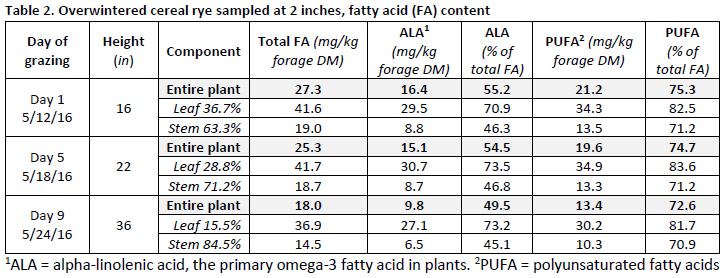
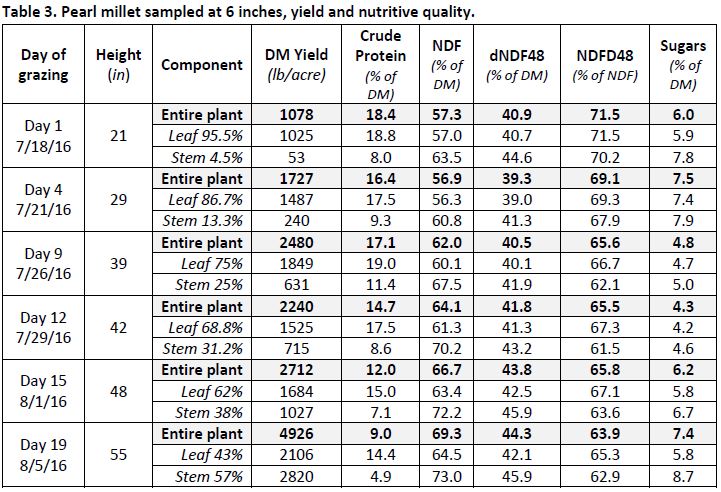
Study 3. Diurnal Variation in Water Soluble Carbohydrates of Pearl Millet Forage -
Hourly changes in WSC of pearl millet on both July 19 (optimum height for grazing) and July 26 (recommended height to harvest for hay or silage) showed a slight accumulation of WSC throughout the day period for both leaf blades and pseudostems (Figure 1); however, individual data points varied widely and overall trends were not very large. Based on this data, we would not expect much difference in animal performance whether grazed mid to late morning or later in the day. This implies that as a supplement, late morning grazing of pearl millet may be best in order to allow the animals access to cool season pasture later in the day when WSC content is higher.
On the average, the pseudostems had about 3% units higher WSC than the leaf blades (Table 4, Figure 1). However, NDF (which limits intake) of pseudostems was always higher compared to the leaf blades and NDF digestibility was always lower, respectively. So, overall forage quality of leaf blades was still higher than pseudostems. This may have implications for stocking rate and grazing pressure especially if grazing more mature stands (such as that collected on 7/26) when the proportion of pseudostem is higher and, thus, digestibility is lower.
Pearl millet had a very high growth rate during this time of year (averaging 155 lbs of dry matter accumulated per acre per day), resulting in an additional 1000 lbs of d.m. per acre when the harvest was delayed from 7/19 to 7/26. However, forage quality did decline most likely due to increases in fiber and lignin content during this one week period.
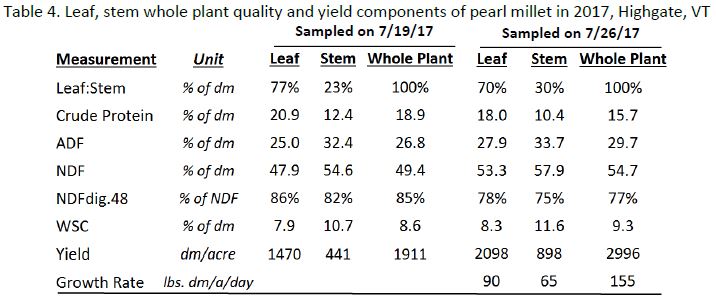

Conclusions
- Changes in the proportion of leaf blades to pseudostem (also called lamina mass ratio or leaf-to-stem ratio) was found to be the greatest factor affecting the decline in nutritional quality and fatty acid content of winter rye and pearl millet as they matured.
- Hourly changes in water-soluble carbohydrates of pearl millet showed a slight accumulation of WSC throughout the day for both leaf blades and pseudostems; however, individual data points varied widely and overall trends were not very large. Based on this data, we would not expect much difference in animal performance whether grazed mid to late morning or later in the day.
Implications and Recommendations
- Grazing management practices that reduce grazing pressure and/or stocking rate could allow for more selective grazing of leaf blades, resulting in a higher intake of high quality forage that is higher in protein, lower in ADF and NDF and higher in NDF digestibility and fatty acid content.
- For grazing annual forages over a long period, it is best to utilize succession plantings to ensure vegetative grazing, however monitoring the proportion of leaf and stem that animals are grazing may help to find the balance of dry matter intake and forage quality that is desired to optimize animal performance.
- When used as a supplement for cool season pasture, late morning grazing of pearl millet may be best in order to allow the animals access to cool season pasture later in the day when WSC content is reported to be higher.
Education & Outreach Activities and Participation Summary
Participation Summary:
Farm tours - We hosted two tours at the Choiniere farm in Aug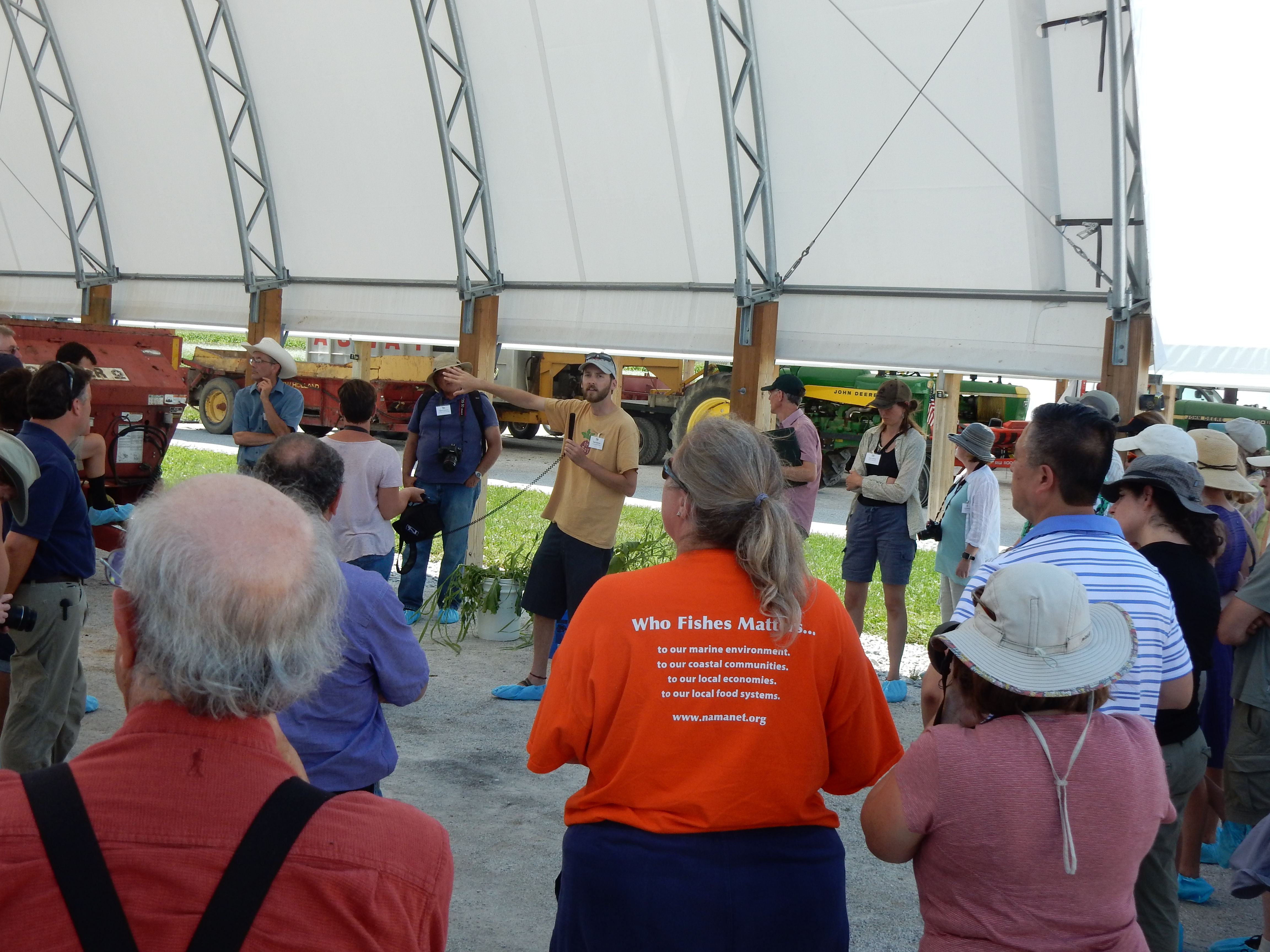 ust of 2016 to highlight the project. One was a sustainable agriculture class from Sterling College and the other was the NE SARE Advisory group tour. They were able to see the annual forage strips and discuss with the Choinieres and researchers about research trial and results.
ust of 2016 to highlight the project. One was a sustainable agriculture class from Sterling College and the other was the NE SARE Advisory group tour. They were able to see the annual forage strips and discuss with the Choinieres and researchers about research trial and results.
Field meeting - We hosted a special field meeting on August 23, 2016 to view the trial and discuss results. Thirteen farmers and related service providers attended.
Conference Presentations - Presentations on the project were made at the following conferences:
Farmer partner Matt Choiniere and PhD candidate Caleb Goossen presented results from this project to the Vermont Grazing and Livestock Conference in Fairlee, Vermont on January 21, 2017.
Caleb Goossen presented the results from this project at the Northeast Pasture Consortium Conference in Hagerstown, MD on March 3, 2017.
Caleb Goossen and Allen Wilder presented the results of the 2017 study at the Vermont Organic Dairy Conference in Randolph, VT on March 15, 2018.
Professional Meeting - We presented a poster about the project at the annual meeting of the American Society of Agronomy/Crop Science Society of America in November 2016 in Phoenix, AZ.
Outreach Publications - Two fact sheets to highlight the results of each year's research were developed as handouts for various field days and meetings. They are also posted on the UVM Crops and Soils website.
Journal Article - One open-sourced journal article was published in the journal Agricultural and Environmental Letters in June 2018. URL:https://dl.sciencesocieties.org/publications/ael/articles/3/1/180016
Learning Outcomes
Two of the farmers that attended the annual forage workshop 2017 VT Grazing Conference indicated that would very likely change their management as a result of the session's presentations and 4 farms indicted they would very likely incorporate annual forages in their grazing programs.
Project Outcomes
Impacts
This project is demonstrating the need to stagger warm season annual plantings in order to have grazing options that maximize yield and quality, as well as providing a greater insight into the changing fatty acid content and profile of annual forages. The results of this project show that, much like many other quality measures, the decline in fatty acid quality of maturing annual forages is resultant from stem elongation, and the resultant dilution of high quality leaf material with fibrous, lower quality pseudostem material. This has implications for fine tuning grazing management when pasturing these fast growing annual crops.
Our findings from this project were presented at on-farm meetings in the summer of 2016 and were highlighted at two farmer conferences in 2017 and one in 2018. A poster of the project was presented at the annual meeting of the American Society of Agronomy in November 2016 as well as the Northeast Pasture Consortium annual meeting in March 2017.
Information Products
- Research Update for SARE Partnership Project on Annual Forages - 2016 (Fact Sheet)
- Can Grazing Selectivity Reduce Fatty Acid Intake Declines in Maturing Annual Forages? (Conference/Presentation Material)
- Research Update for SARE Partnership Project on Annual Forages - 2017 (Fact Sheet)
- Fatty Acids Decrease in Pearl Millet Forage from Relative Increases of Pseudostem (Peer-reviewed Journal Article)